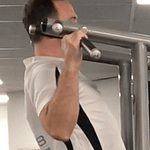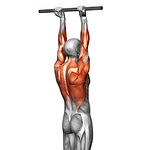The Chin Ups, also known as pull-ups are extremely challenging yet beneficial exercises that will push your upper body to its limits. Chin-ups are a closed-chain exercise, meaning your hands are fixed and don’t move during the entire exercise. These forms of exercise result in greater muscle fibre recruitment. Additionally, chin-ups are a compound exercise that uses multiple muscles and joints during the movement, making them extremely functional whilst mimicking many movements you complete in daily life.
The chin-up exercise can be used for many elements of health which are noted below:
Another great thing about this exercise is that it can be modified in various ways to suit every fitness and training level you may be at, and with it being a compound exercise, time efficiency makes this exercise extremely valuable.
Changes in grip and hand positioning will alter the mechanics and muscular recruitment, making some variations easier or harder than others. Adding assistance via a machine or resistance band is another common variation of the traditional chin-up. This assistance helps propel you upwards, making the exercise easier to complete. We have provided a simple progression bar below for your reference.
The L-sit chin-up is one of the most advanced chin-up exercises and is commonly performed by gymnasts so you may have seen it at the Olympics. This variation combines a chin-up with an isometric hanging leg raise hold, significantly increasing the demands placed on all your core muscles throughout the movement. This is an advanced upper body test when compared to the Wide Grip Chin Up, utilising your intricate muscles in your arms and shoulders, Latissimus Dorsi, Rhomboids, Biceps, Forearms, Trapezius (Traps), as well as your core strength. This effective compound exercise is a fantastic way to build your neuromuscular strength, endurance and hypertrophy, depending on training outcomes! Use our simple progressions below to build up to this amazing exercise!
Before jumping to the L-Sit Chin Ups, it is vital to gradually build up the capacity and strength to try these more challenging variations. This will ensure safety and technique are maintained. Some exercise progressions have been included in this blog to work through and master before attempting the more progressed chin-up variations. In addition, further progressions to this exercise can be added, which we will discuss in future blogs!

The benefits of chin ups can be lengthy! To start, they are a fantastic compound exercise that can be completed in various ways, utilising several muscles within one movement and can be progressed or regressed to suit your needs. Due to this, its efficiency and effectiveness are next to none when it comes to strengthening your body and increasing your ability to do tasks we are faced with in everyday life. There are further benefits in assisting with lower back problems, posture and overall grip strength.

With more focus on the upper body, the Chin Up movement recruits several muscles to help do so. Activation of your Latisimus Dorsi (Lats), trapezius (traps), biceps, rhomboids, forearms and core muscles is critical in completing a chin-up.
By doing so, an expected increase in neuromuscular strength, endurance and hypertrophy (depending on your uses in your workouts) is expected.
These improvements can be transferred into functional strengthening and injury prevention when possible!

As with all exercises, it is critical that you gradually build up to these more challenging exercises to ensure safety is maintained. A safe exercise progression may include the following;
Lat-Pull Down
Assisted Neutral/Under Grip Chin Ups
Assisted Chin Ups (Wide Grip)
Chin Hold (Neutral/Under/Wide Grip)
Neutral/Under Grip Chin Ups
Wide Grip Chin-Up
L-Sit Chin Ups
Note: This exercise can be further progressed for added benefits!
The Chin-Up is a fantastic compound exercise that can be completed in various ways! What this means is that this exercise utilises several muscles within one movement and can be progressed or regressed to suit your needs. Due to this, its efficiency and effectiveness are next to none when it comes to strengthening your body and increasing your ability to do tasks we are faced with in everyday life.
To perform this exercise, follow these steps;

This functional exercise recruits several muscles during each phase of the movement. The main muscles recruited can depend on your hand grip, as different grip positions change the biomechanics of the movement, and therefore the muscles recruited. For example:
The Chin-Up is a compound exercise, several muscles are engaged during the movement. Because of this, exercise efficiency and effectiveness are at an optimal level. In saying this, because there is such a vast variety of ways to complete this exercise, each way has its dominant neuromuscular benefits;
a) Wide-Grip Chin-Up
Being the most difficult of the three positions, the Wide-grip Chin-Up utilises your Latisimus Dorsi (Lats), Trapezius (Traps), Rhomboids, and Thoracic Erector Spinae muscles. This is the most difficult as there is greater activation on your lats to be able to complete the movement.
b) Neutral-Grip Chin-Up
With the Neutral-Grip Chin-Up, engagement of the Biceps Brachii is involved during this movement, as to which can be much easier when compared to the Wide-Grip Chin-Up. It is critical to note that, although there is a change in grip, lats, traps, and rhomboid activation are still present throughout, but not as heavily targeted.
c) Under-Grip Chin-Up
Also known as the biceps chin-ups, the Under-Grip Chin-Up utilises the Biceps, Lats, Traps and Rhomboids throughout the movement, but it is vital to understand that there is a greater engagement of your Pectoral (chest) muscles during this.
In essence, the Chin-Up is a very challenging exercise despite the way it is completed. During the movement, engagement of your core and forearm muscles is relatively consistent throughout all ways of completing the exercise.
As with all exercises, it is critical that you gradually build up to these more challenging exercises to ensure safety is maintained. In saying this, many more exercise variations differentiate from your strict chin-ups that can be implemented, such as negative chin-ups. Keeping this in mind, stay tuned for further blogs that will run through these further variations.
We have provided a safe exercise progression below with video demonstrations of each to help you.

If you have any further questions, please contact us anytime.
NOTE: This exercise can be further regressed and/or progressed, which we will review in further blogs so stay tuned!
The Chin-Up is a fantastic closed-chain, compound upper-body exercise that can be simply modified to make the exercise easier or harder depending on your capabilities. It is a great way to obtain the desired neuromuscular benefits in an efficient yet effective manner.
There are many progressive options for the chin-up when you start to find them easier, with the L-Sit Chin-Up being a brilliant advanced exercise that you should gradually build up to and integrate into your training regime once your body is conditioned.
Following our safe progressive exercises shown above and you will find yourself at that level quicker than you think!
If you need further guidance, please reach out to us and take advantage of a free 15-minute telehealth consultation with our exercise physiologist.
Written by Paolo Mitry, an Exercise Physiologist at Activ8 Health Club.